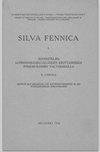作为多孔真菌栖息地的北方和半北方草本丰富森林的特征
IF 1.7
3区 农林科学
Q2 FORESTRY
引用次数: 1
摘要
草本植物丰富的森林通常被认为是北方地区生物多样性的热点,但其真菌组合,特别是木材腐烂真菌的组合,仍然知之甚少。我们研究了富含草药的森林作为多孔真菌(一种独特的木材腐烂真菌)的栖息地,并评估了树木和林分尺度变量对多孔真菌物种丰富度、丰度和多样性的重要性,包括红色名录物种。数据包括芬兰71个富含草本植物的林分和4797个枯木项目,对101种多孔植物进行了2832次观测。枯木多样性是解释多孔物种丰富度和多样性的最重要变量,而纬度增加对多孔物种丰富度和多样性有负向影响。红皮书树种对大直径枯枝的丰度表现出积极的响应,特别是桦木,也支持了高的多孔总体丰度。多孔组合的组成反映了其寄主树种。红色名单物种在排序空间中没有明显的模式。与原始云杉林相比,富含草药的森林似乎拥有较低的多孔物种丰富度和较少的红名单物种。然而,由于落叶乔木在枯木剖面中所占的比例较高,在北方针叶林景观中,富含草本植物的森林对多孔植物组合具有明显的互补作用。本文章由计算机程序翻译,如有差异,请以英文原文为准。
Characteristics of boreal and hemiboreal herb-rich forests as habitats for polypore fungi
Herb-rich forests are often considered biodiversity hotspots in the boreal zone but their fungal assemblages, particularly those of wood-decaying fungi, remain poorly known. We studied herb-rich forests as habitats for polypores, a distinct group of wood-decaying fungi, and assessed the importance of treeand stand-scale variables for polypore species richness, abundance, and diversity, including red-listed species. The data include 71 herb-rich forest stands in Finland and 4797 dead wood items, on which we made 2832 observations of 101 polypore species. Dead-wood diversity was the most important variable explaining polypore species richness and diversity, whereas increasing latitude had a negative effect. Red-listed species showed a positive response to the abundance of large-diameter dead wood, which, especially birch, supported also high general abundance of polypores. The composition of polypore assemblages reflected their host-tree species. The red-listed species did not show explicit patterns in the ordination space. Compared to old-growth spruce forests, herb-rich forests seem to host lower polypore species richness and less red-listed species. However, because of high proportion of deciduous trees in the dead wood profile, herb-rich forests have a clear complementary effect on polypore assemblages in boreal forest landscapes.
求助全文
通过发布文献求助,成功后即可免费获取论文全文。
去求助
来源期刊

Silva Fennica
农林科学-林学
CiteScore
3.50
自引率
11.10%
发文量
21
审稿时长
3 months
期刊介绍:
Silva Fennica publishes significant new knowledge on forest sciences. The scope covers research on forestry and forest ecosystems. Silva Fennica aims to increase understanding on forest ecosystems, and sustainable use and conservation of forest resources. Use of forest resources includes all aspects of forestry containing biomass-based and non-timber products, economic and social factors etc.
 求助内容:
求助内容: 应助结果提醒方式:
应助结果提醒方式:


